Global Research Trends and Hotspots on Mitochondria in Acute Lung Injury from 2012–2021: A Bibliometric Analysis
Abstract
1. Introduction
2. Materials and Methods
2.1. Data Collection
2.2. Bibliometric Analysis
3. Results
3.1. The Global Overview of Publications
3.2. The Annual Trend of Publication Quantity
3.3. Analysis of Countries and Institutions
3.4. Analysis of Journals and Disciplines
3.5. Analysis of Local Citation Score (LCS)
3.6. Analysis of Hotspots and Frontiers
3.7. Analysis of Co-Cited Reference Clusters
3.8. Burst Detection
4. Discussion
5. Conclusions
Author Contributions
Funding
Data Availability Statement
Acknowledgments
Conflicts of Interest
Abbreviations
References
- Shah, F.A.; Meyer, N.J.; Angus, D.C.; Awdish, R.; Azoulay, É.; Calfee, C.S.; Clermont, G.; Gordon, A.C.; Kwizera, A.; Leligdowicz, A.; et al. A Research Agenda for Precision Medicine in Sepsis and Acute Respiratory Distress Syndrome: An Official American Thoracic Society Research Statement. Am. J. Respir. Crit. Care Med. 2021, 204, 891–901. [Google Scholar] [CrossRef] [PubMed]
- ARDS Definition of Task Force; Ranieri, V.M.; Rubenfeld, G.D.; Thompson, B.T.; Ferguson, N.D.; Caldwell, E.; Fan, E.; Camporota, L.; Slutsky, A.S. Acute Respiratory Distress Syndrome: The Berlin Definition. JAMA 2012, 307, 2526–2533. [Google Scholar] [CrossRef] [PubMed]
- Bellani, G.; Laffey, J.G.; Pham, T.; Fan, E.; Brochard, L.; Esteban, A.; Gattinoni, L.; Van Haren, F.; Larsson, A.; McAuley, D.F.; et al. Epidemiology, Patterns of Care, and Mortality for Patients with Acute Respiratory Distress Syndrome in Intensive Care Units in 50 Countries. JAMA 2016, 315, 788–800. [Google Scholar] [CrossRef] [PubMed]
- Meyer, N.J.; Gattinoni, L.; Calfee, C.S. Acute Respiratory Distress Syndrome. Lancet 2021, 398, 622–637. [Google Scholar] [CrossRef] [PubMed]
- Matthay, M.A.; Zemans, R.L.; Zimmerman, G.A.; Arabi, Y.M.; Beitler, J.R.; Mercat, A.; Herridge, M.; Randolph, A.G.; Calfee, C.S. Acute Respiratory Distress Syndrome. Nat. Rev. Dis. Prim. 2019, 5, 18. [Google Scholar] [CrossRef]
- Pham, T.; Pesenti, A.; Bellani, G.; Rubenfeld, G.; Fan, E.; Bugedo, G.; Lorente, J.A.; Fernandes, A.D.V.; Van Haren, F.; Bruhn, A.; et al. Outcome of Acute Hypoxaemic Respiratory Failure: Insights from the Lung Safe Study. Eur. Respir. J. 2021, 57, 2003317. [Google Scholar] [CrossRef]
- Johnson, E.R.; Matthay, M.A. Acute Lung Injury: Epidemiology, Pathogenesis, and Treatment. J. Aerosol. Med. Pulm. Drug Deliv. 2010, 23, 243–252. [Google Scholar] [CrossRef]
- Choudhuri, S.; Chowdhury, I.H.; Garg, N.J. Mitochondrial Regulation of Macrophage Response against Pathogens. Front. Immunol. 2020, 11, 622602. [Google Scholar] [CrossRef]
- Dumont, A.; Lee, M.; Barouillet, T.; Murphy, A.; Yvan-Charvet, L. Mitochondria Orchestrate Macrophage Effector Functions in Atherosclerosis. Mol. Asp. Med. 2021, 77, 100922. [Google Scholar] [CrossRef]
- Artyomov, M.N.; Sergushichev, A.; Schilling, J.D. Integrating Immunometabolism and Macrophage Diversity. Semin. Immunol. 2016, 28, 417–424. [Google Scholar] [CrossRef]
- Ramond, E.; Jamet, A.; Coureuil, M.; Charbit, A. Pivotal Role of Mitochondria in Macrophage Response to Bacterial Pathogens. Front. Immunol. 2019, 10, 2461. [Google Scholar] [CrossRef]
- Wang, Y.; Li, N.; Zhang, X.; Horng, T. Mitochondrial Metabolism Regulates Macrophage Biology. J. Biol. Chem. 2021, 297, 100904. [Google Scholar] [CrossRef]
- Porporato, P.E.; Filigheddu, N.; Pedro, J.M.B.; Kroemer, G.; Galluzzi, L. Mitochondrial Metabolism and Cancer. Cell. Res. 2018, 28, 265–280. [Google Scholar] [CrossRef]
- Rensvold, J.W.; Shishkova, E.; Sverchkov, Y.; Miller, I.J.; Cetinkaya, A.; Pyle, A.; Manicki, M.; Brademan, D.R.; Alanay, Y.; Raiman, J.; et al. Defining Mitochondrial Protein Functions through Deep Multiomic Profiling. Nature 2022, 606, 382–388. [Google Scholar] [CrossRef]
- Sharma, A.; Ahmad, S.; Ahmad, T.; Ali, S.; Syed, M.A. Mitochondrial Dynamics and Mitophagy in Lung Disorders. Life Sci. 2021, 284, 119876. [Google Scholar] [CrossRef]
- Rowlands, D.J. Mitochondria dysfunction: A novel therapeutic target in pathological lung remodeling or bystander? Pharm. Ther. 2016, 166, 96–105. [Google Scholar] [CrossRef]
- Lerner, C.A.; Sundar, I.K.; Rahman, I. Mitochondrial Redox System, Dynamics, and Dysfunction in Lung Inflammaging and Copd. Int. J. Biochem. Cell. Biol. 2016, 81 Pt B, 294–306. [Google Scholar] [CrossRef]
- Khan, M.S.; Ullah, W.; Bin Riaz, I.; Bhulani, N.; Manning, W.J.; Tridandapani, S.; Khosa, F. Top 100 Cited Articles in Cardiovascular Magnetic Resonance: A Bibliometric Analysis. J. Cardiovasc. Magn. Reason. 2016, 18, 87. [Google Scholar] [CrossRef]
- Chen, S.; Zhang, Y.; Dai, W.; Qi, S.; Tian, W.; Gu, X.; Chen, X.; Yu, W.; Tian, J.; Su, D. Publication Trends and Hot Spots in Postoperative Cognitive Dysfunction Research: A 20-Year Bibliometric Analysis. J. Clin. Anesth. 2020, 67, 110012. [Google Scholar] [CrossRef]
- Seriwala, H.M.; Khan, M.S.; Shuaib, W.; Shah, S.R. Bibliometric Analysis of the Top 50 Cited Respiratory Articles. Expert Rev. Respir. Med. 2015, 9, 817–824. [Google Scholar] [CrossRef]
- Huang, X.; Liu, X.; Shang, Y.; Qiao, F.; Chen, G. Current Trends in Research on Bone Regeneration: A Bibliometric Analysis. Biomed. Res. Int. 2020, 2020, 8787394. [Google Scholar] [CrossRef] [PubMed]
- Qiu, Y.; Yang, W.; Wang, Q.; Yan, S.; Li, B.; Zhai, X. Osteoporosis in Postmenopausal Women in This Decade: A Bibliometric Assessment of Current Research and Future Hotspots. Arch. Osteoporos. 2018, 13, 121. [Google Scholar] [CrossRef] [PubMed]
- He, J.; He, L.; Geng, B.; Xia, Y. Bibliometric Analysis of the Top-Cited Articles on Unicompartmental Knee Arthroplasty. J. Arthroplast. 2021, 36, 1810–1818.e3. [Google Scholar] [CrossRef] [PubMed]
- Shah, S.M.; Ahmad, T.; Chen, S.; Yuting, G.; Liu, X.; Yuan, Y. A Bibliometric Analysis of the One Hundred Most Cited Studies in Psychosomatic Research. Psychother. Psychosom. 2021, 90, 425–430. [Google Scholar] [CrossRef] [PubMed]
- Ogunsakin, R.E.; Ebenezer, O.; Ginindza, T.G. A Bibliometric Analysis of the Literature on Norovirus Disease from 1991–2021. Int. J. Environ. Res. Public Health 2022, 19, 2508. [Google Scholar] [CrossRef] [PubMed]
- Ogunsakin, R.E.; Ebenezer, O.; Jordaan, M.A.; Shapi, M.; Ginindza, T.G. Mapping Scientific Productivity Trends and Hotspots in Remdesivir Research Publications: A Bibliometric Study from 2016 to 2021. Int. J. Environ. Res. Public Health 2022, 19, 8845. [Google Scholar] [CrossRef] [PubMed]
- You, Y.; Li, W.; Liu, J.; Li, X.; Fu, Y.; Ma, X. Bibliometric Review to Explore Emerging High-Intensity Interval Training in Health Promotion: A New Century Picture. Front Public Health 2021, 9, 697633. [Google Scholar] [CrossRef]
- Igwaran, A.; Edoamodu, C.E. Bibliometric Analysis on Tuberculosis and Tuberculosis-Related Research Trends in Africa: A Decade-Long Study. Antibiotics 2021, 10, 423. [Google Scholar] [CrossRef]
- Landis, J.R.; Koch, G.G. The Measurement of Observer Agreement for Categorical Data. Biometrics 1977, 33, 159–174. [Google Scholar] [CrossRef]
- Wang, S.; Zhou, H.; Zheng, L.; Zhu, W.; Zhu, L.; Feng, D.; Wei, J.; Chen, G.; Jin, X.; Yang, H.; et al. Global Trends in Research of Macrophages Associated with Acute Lung Injury over Past 10 Years: A Bibliometric Analysis. Front. Immunol. 2021, 12, 669539. [Google Scholar] [CrossRef]
- Li, T.; Yang, A.; Liu, G.; Zou, S.; Chen, Y.; Ni, B.; Liu, Y.; Fan, J. Status Quo and Research Trends of Craniopharyngioma Research: A 10-Year Bibliometric Analyses (from 2011 to 2020). Front. Oncol. 2021, 11, 744308. [Google Scholar] [CrossRef]
- Hirsch, J.E. An Index to Quantify an Individual’s Scientific Research Output. Proc. Natl. Acad. Sci. USA 2005, 102, 16569–16572. [Google Scholar] [CrossRef]
- Moed, H.F. New Developments in the Use of Citation Analysis in Research Evaluation. Arch. Immunol. Ex 2009, 57, 13–18. [Google Scholar] [CrossRef]
- Brandt, J.S.; Hadaya, O.; Schuster, M.; Rosen, T.; Sauer, M.V.; Ananth, C.V. A Bibliometric Analysis of Top-Cited Journal Articles in Obstetrics and Gynecology. JAMA Netw. Open 2019, 2, e1918007. [Google Scholar] [CrossRef]
- Jones, T.; Huggett, S.; Kamalski, J. Finding a Way through the Scientific Literature: Indexes and Measures. World Neurosurg. 2011, 76, 36–38. [Google Scholar] [CrossRef]
- Roldan-Valadez, E.; Salazar-Ruiz, S.Y.; Ibarra-Contreras, R.; Rios, C. Current Concepts on Bibliometrics: A Brief Review About Impact Factor, Eigenfactor Score, Citescore, Scimago Journal Rank, Source-Normalised Impact Per Paper, H-Index, and Alternative Metrics. Ir. J. Med. Sci. 2019, 188, 939–951. [Google Scholar] [CrossRef]
- Van Eck, N.J.; Waltman, L. Software Survey: Vosviewer, a Computer Program for Bibliometric Mapping. Scientometrics 2010, 84, 523–538. [Google Scholar] [CrossRef]
- Yao, L.; Hui, L.; Yang, Z.; Chen, X.; Xiao, A. Freshwater Microplastics Pollution: Detecting and Visualizing Emerging Trends Based on Citespace Ii. Chemosphere 2020, 245, 125627. [Google Scholar] [CrossRef]
- Chen, C. Searching for Intellectual Turning Points: Progressive Knowledge Domain Visualization. Proc. Natl. Acad. Sci. USA 2004, 101 (Suppl. 1), 5303–5310. [Google Scholar] [CrossRef]
- Liu, S.; Sun, Y.P.; Gao, X.L.; Sui, Y. Knowledge Domain and Emerging Trends in Alzheimer’s Disease: A Scientometric Review Based on Citespace Analysis. Neural. Regen. Res. 2019, 14, 1643–1650. [Google Scholar] [CrossRef]
- Aria, M.; Cuccurullo, C. Bibliometrix: An R-Tool for Comprehensive Science Mapping Analysis. J. Informetr. 2017, 11, 959–975. [Google Scholar] [CrossRef]
- Hao, X.; Liu, Y.; Li, X.; Zheng, J. Visualizing the History and Perspectives of Disaster Medicine: A Bibliometric Analysis. Disaster Med. Public Health Prep. 2019, 13, 966–973. [Google Scholar] [CrossRef] [PubMed]
- Frame, J.D.; Baum, J.J.; Card, M. An Information Approach to Examining Developments in an Energy Technology: Coal Gasification. J. Am. Soc. Inf. Sci. Technol. 2014, 30, 193–201. [Google Scholar] [CrossRef]
- Chen, C. Science Mapping: A Systematic Review of the Literature. J. Data Inf. Sci. 2017, 2, 1–40. [Google Scholar] [CrossRef]
- Chen, C.; Leydesdorff, L. Patterns of Connections and Movements in Dual-Map Overlays: A New Method of Publication Portfolio Analysis. J. Assoc. Inf. Sci. Technol. 2014, 65, 334–351. [Google Scholar] [CrossRef]
- Islam, M.N.; Das, S.R.; Emin, M.T.; Wei, M.; Sun, L.; Westphalen, K.; Rowlands, D.J.; Quadri, S.K.; Bhattacharya, S.; Bhattacharya, J. Mitochondrial Transfer from Bone-Marrow-Derived Stromal Cells to Pulmonary Alveoli Protects against Acute Lung Injury. Nat. Med. 2012, 18, 759–765. [Google Scholar] [CrossRef]
- Jackson, M.V.; Morrison, T.J.; Doherty, D.F.; McAuley, D.F.; Matthay, M.A.; Kissenpfennig, A.; O’Kane, C.M.; Krasnodembskaya, A.D. Mitochondrial Transfer Via Tunneling Nanotubes Is an Important Mechanism by Which Mesenchymal Stem Cells Enhance Macrophage Phagocytosis in the in Vitro and in Vivo Models of Ards. Stem Cells 2016, 34, 2210–2223. [Google Scholar] [CrossRef]
- Morrison, T.J.; Jackson, M.V.; Cunningham, E.K.; Kissenpfennig, A.; McAuley, D.F.; O’Kane, C.M.; Krasnodembskaya, A.D. Mesenchymal Stromal Cells Modulate Macrophages in Clinically Relevant Lung Injury Models by Extracellular Vesicle Mitochondrial Transfer. Am. J. Respir. Crit. Care Med. 2017, 196, 1275–1286. [Google Scholar] [CrossRef]
- Faust, H.E.; Reilly, J.P.; Anderson, B.J.; Ittner, C.A.; Forker, C.M.; Zhang, P.; Weaver, B.A.; Holena, D.N.; Lanken, P.N.; Christie, J.D.; et al. Plasma Mitochondrial DNA Levels Are Associated with Ards in Trauma and Sepsis Patients. Chest 2020, 157, 67–76. [Google Scholar] [CrossRef]
- Athale, J.; Ulrich, A.; MacGarvey, N.C.; Bartz, R.R.; Welty-Wolf, K.E.; Suliman, H.B.; Piantadosi, C.A. Nrf2 Promotes Alveolar Mitochondrial Biogenesis and Resolution of Lung Injury in Staphylococcus Aureus Pneumonia in Mice. Free Radic. Biol. Med. 2012, 53, 1584–1594. [Google Scholar] [CrossRef]
- Gonzalez, A.S.; Elguero, M.E.; Finocchietto, P.; Holod, S.; Romorini, L.; Miriuka, S.G.; Peralta, J.G.; Poderoso, J.J.; Carreras, M.C. Abnormal Mitochondrial Fusion-Fission Balance Contributes to the Progression of Experimental Sepsis. Free Radic. Res. 2014, 48, 769–783. [Google Scholar] [CrossRef]
- Yuan, Z.; Syed, M.A.; Panchal, D.; Joo, M.; Colonna, M.; Brantly, M.; Sadikot, R.T. Triggering Receptor Expressed on Myeloid Cells 1 (Trem-1)-Mediated Bcl-2 Induction Prolongs Macrophage Survival. J. Biol. Chem. 2014, 289, 15118–15129. [Google Scholar] [CrossRef]
- Chang, A.; Ulrich, A.; Suliman, H.; Piantadosi, C. Redox Regulation of Mitophagy in the Lung During Murine Staphylococcus Aureus Sepsis. Free Radic. Biol. Med. 2015, 78, 179–189. [Google Scholar] [CrossRef] [PubMed]
- Zhang, Y.; Sauler, M.; Shinn, A.S.; Gong, H.; Haslip, M.; Shan, P.; Mannam, P.; Lee, P.J. Endothelial Pink1 Mediates the Protective Effects of Nlrp3 Deficiency During Lethal Oxidant Injury. J. Immunol. 2014, 192, 5296–5304. [Google Scholar] [CrossRef]
- Nakahira, K.; Kyung, S.-Y.; Rogers, A.J.; Gazourian, L.; Youn, S.; Massaro, A.F.; Quintana, C.; Osorio, J.C.; Wang, Z.; Zhao, Y.; et al. Circulating Mitochondrial DNA in Patients in the Icu as a Marker of Mortality: Derivation and Validation. PLoS Med. 2013, 10, e1001577. [Google Scholar] [CrossRef]
- Lee, Y.-L.; King, M.B.; Gonzalez, R.P.; Brevard, S.B.; Frotan, M.A.; Gillespie, M.N.; Simmons, J.D. Blood Transfusion Products Contain Mitochondrial DNA Damage-Associated Molecular Patterns: A Potential Effector of Transfusion-Related Acute Lung Injury. J. Surg. Res. 2014, 191, 286–289. [Google Scholar] [CrossRef]
- Boudreau, L.H.; Duchez, A.-C.; Cloutier, N.; Soulet, D.; Martin, N.; Bollinger, J.; Paré, A.; Rousseau, M.; Naika, G.S.; Lévesque, T.; et al. Platelets Release Mitochondria Serving as Substrate for Bactericidal Group Iia-Secreted Phospholipase A2 to Promote Inflammation. Blood 2014, 124, 2173–2183. [Google Scholar] [CrossRef]
- Yu, J.; Shi, J.; Wang, D.; Dong, S.; Zhang, Y.; Wang, M.; Gong, L.; Fu, Q.; Liu, D. Heme Oxygenase-1/Carbon Monoxide-Regulated Mitochondrial Dynamic Equilibrium Contributes to the Attenuation of Endotoxin-Induced Acute Lung Injury in Rats and in Lipopolysaccharide-Activated Macrophages. Anesthesiology 2016, 125, 1190–1201. [Google Scholar] [CrossRef]
- Laffey, J.; Matthay, M. Years of Research in ARDS.Cell-based Therapy for Acute Respiratory Distress Syndrome. Biology and Potential Therapeutic Value. Am. J. Respir. Crit. Care Med. 2017, 196, 266–273. [Google Scholar] [CrossRef]
- Puri, G.; Naura, A.S. Critical Role of Mitochondrial Oxidative Stress in Acid Aspiration Induced Ali in Mice. Toxicol. Mech. Methods 2020, 30, 266–274. [Google Scholar] [CrossRef]
- Liu, X.; Chen, Z. The Pathophysiological Role of Mitochondrial Oxidative Stress in Lung Diseases. J. Transl. Med. 2017, 15, 207. [Google Scholar] [CrossRef] [PubMed]
- Singh, K.K.; Chaubey, G.; Chen, J.Y.; Suravajhala, P. Decoding Sars-Cov-2 Hijacking of Host Mitochondria in Covid-19 Pathogenesis. Am. J. Physiol. Cell Physiol. 2020, 319, C258–C267. [Google Scholar] [CrossRef] [PubMed]
- Saleh, J.; Peyssonnaux, C.; Singh, K.K.; Edeas, M. Mitochondria and Microbiota Dysfunction in COVID-19 Pathogenesis. Mitochondrion 2020, 54, 1–7. [Google Scholar] [CrossRef]
- Shi, C.-S.; Qi, H.-Y.; Boularan, C.; Huang, N.-N.; Abu-Asab, M.; Shelhamer, J.H.; Kehrl, J.H. Sars-Coronavirus Open Reading Frame-9b Suppresses Innate Immunity by Targeting Mitochondria and the Mavs/Traf3/Traf6 Signalosome. J. Immunol. 2014, 193, 3080–3089. [Google Scholar] [CrossRef]
- Malavolta, M.; Giacconi, R.; Brunetti, D.; Provinciali, M.; Maggi, F. Exploring the Relevance of Senotherapeutics for the Current Sars-Cov-2 Emergency and Similar Future Global Health Threats. Cells 2020, 9, 909. [Google Scholar] [CrossRef]
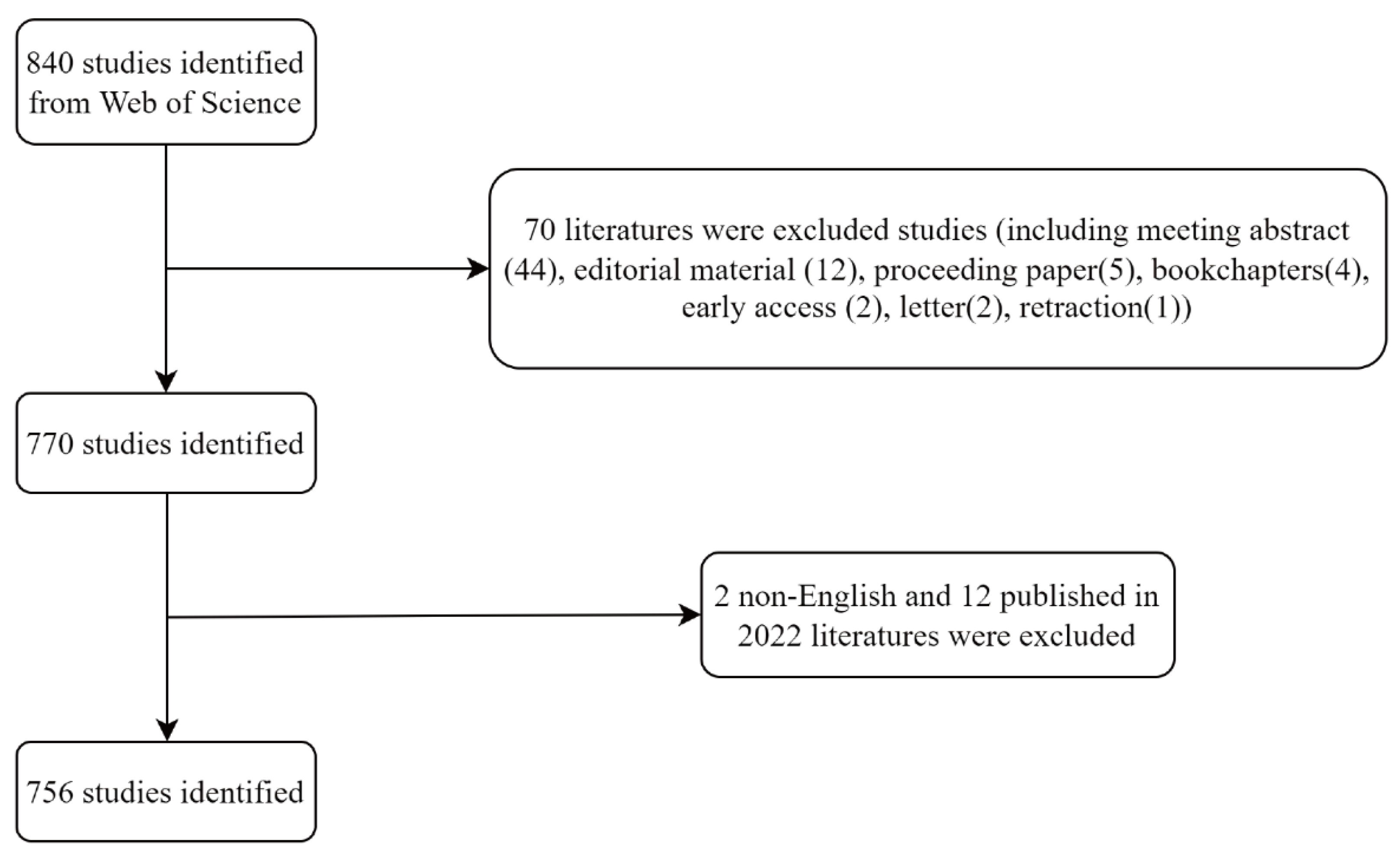
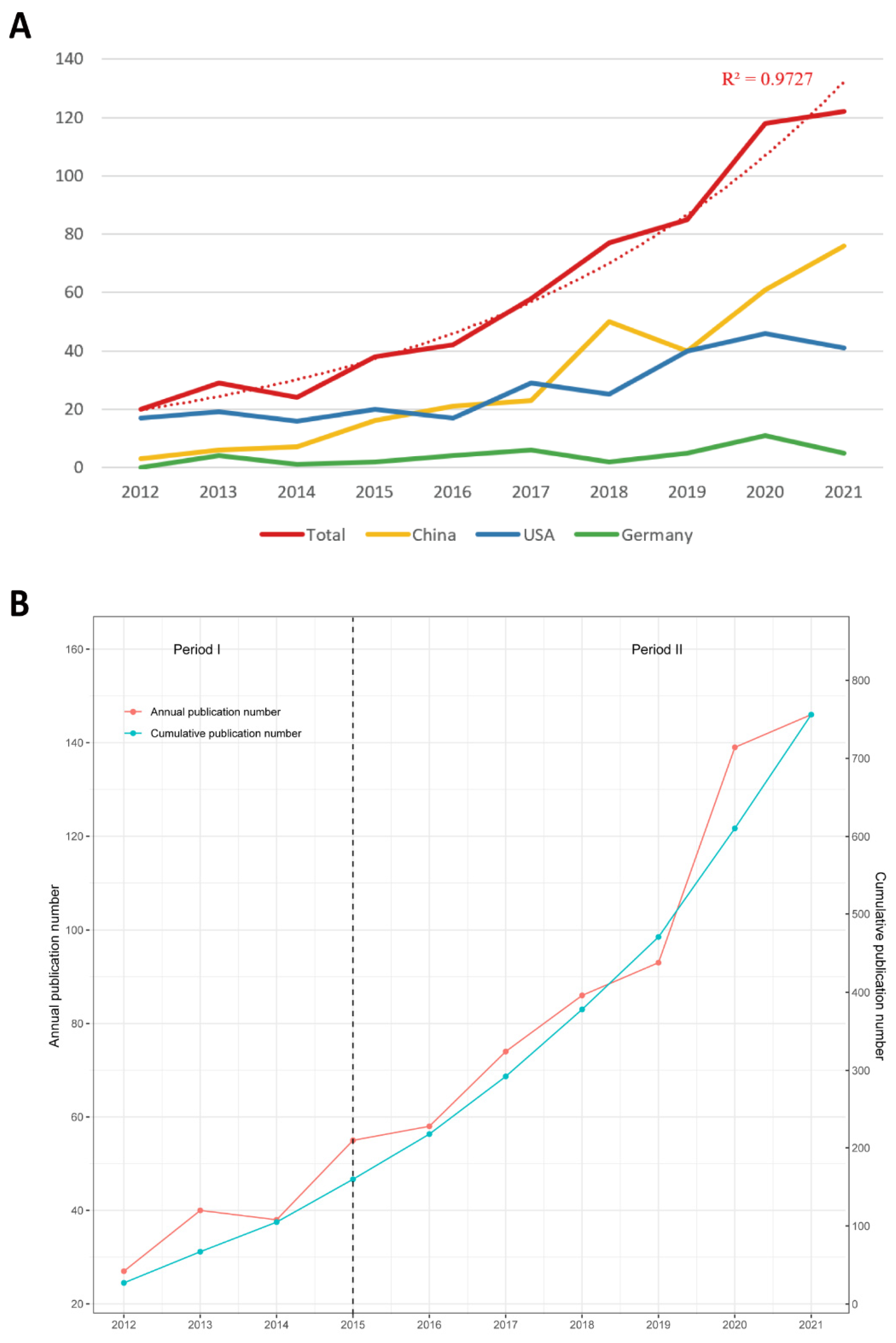
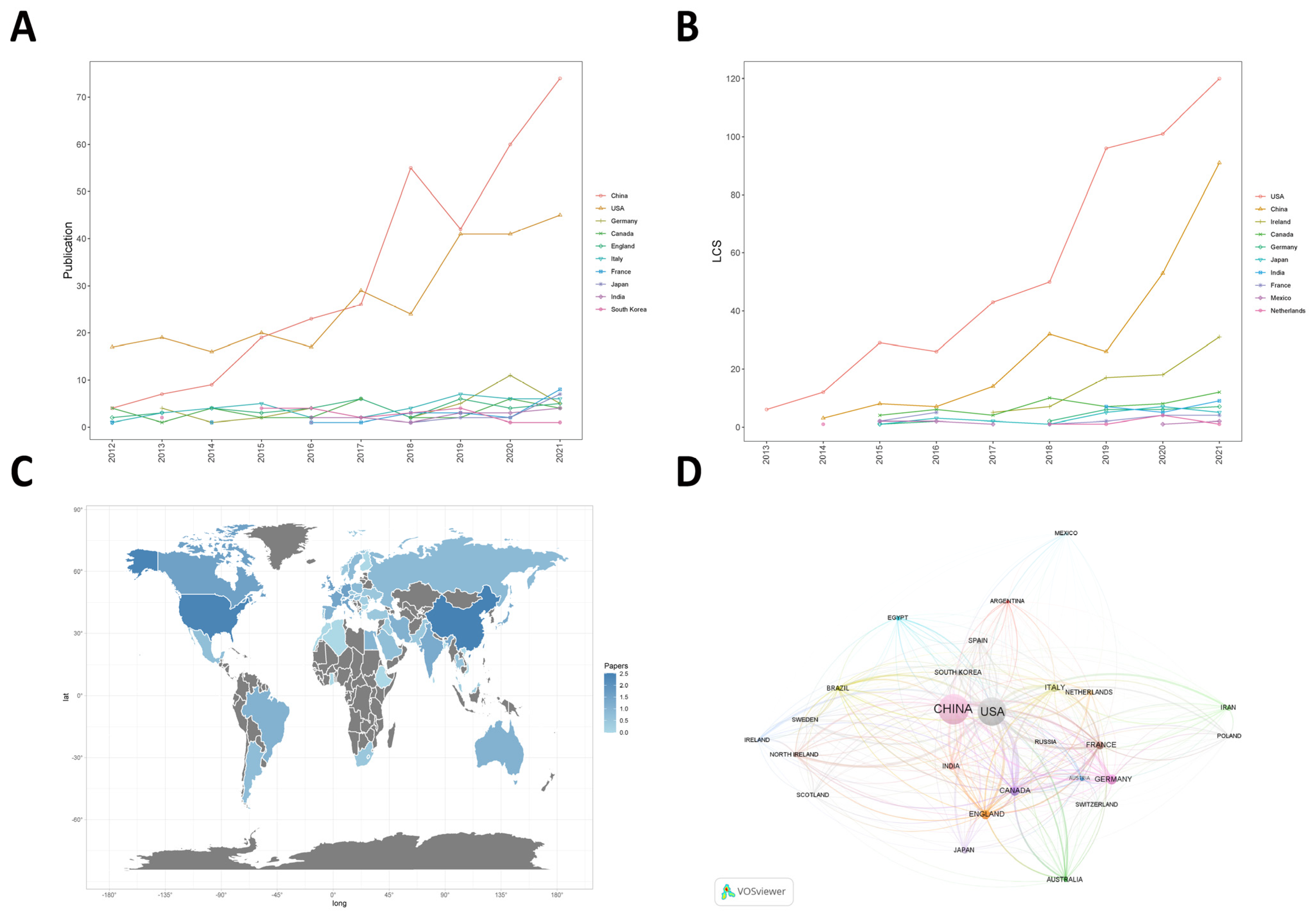
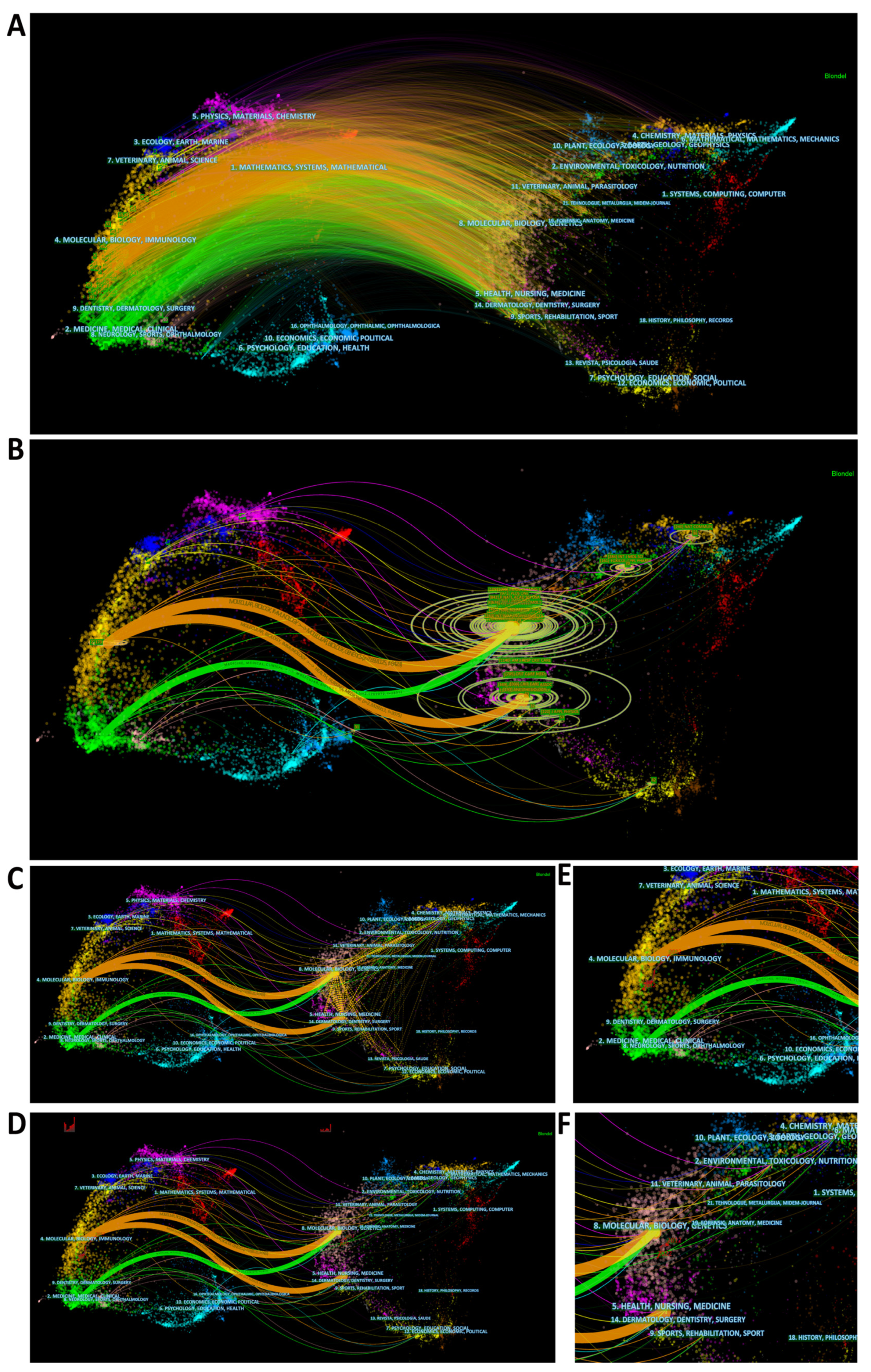
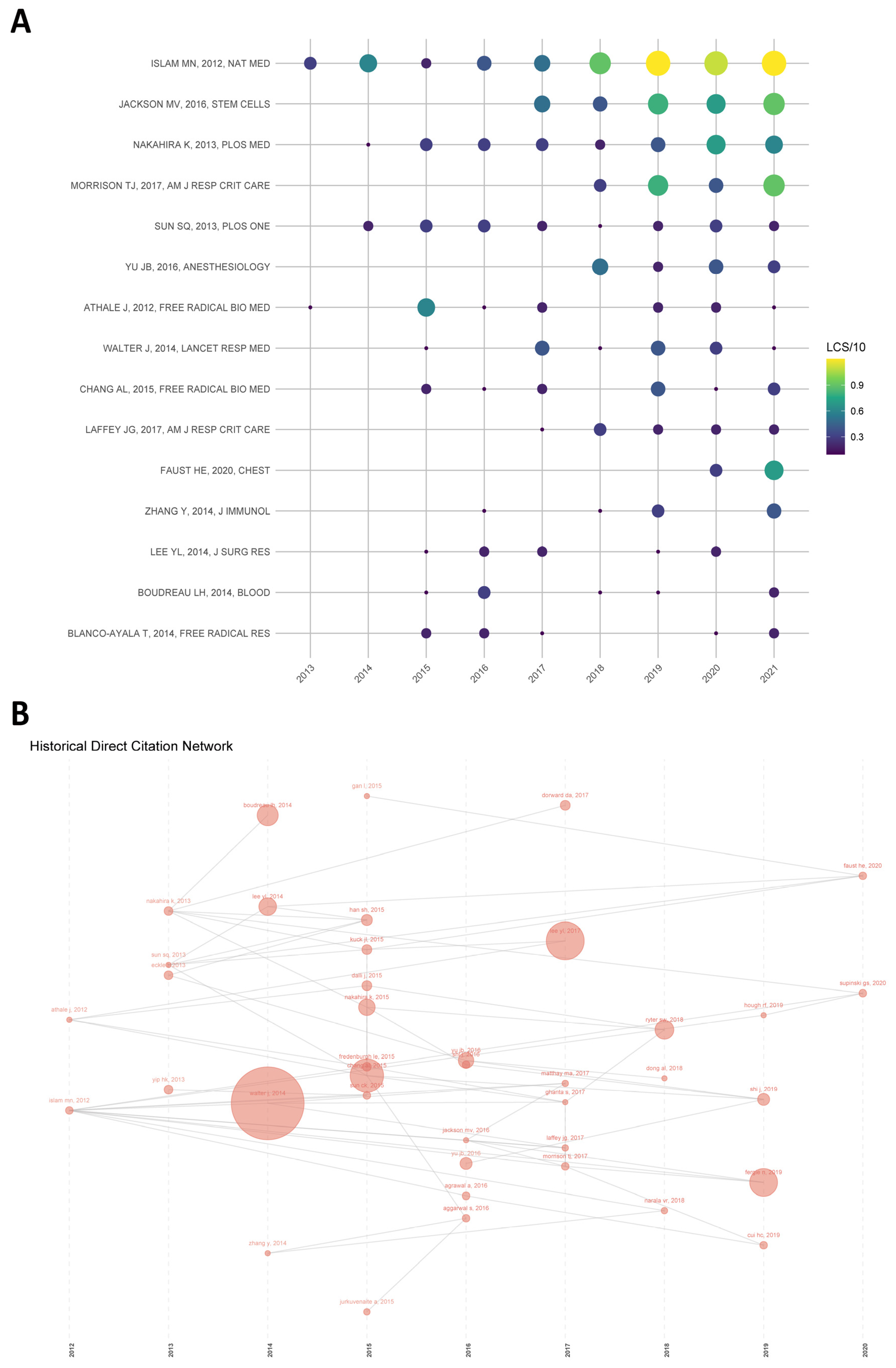
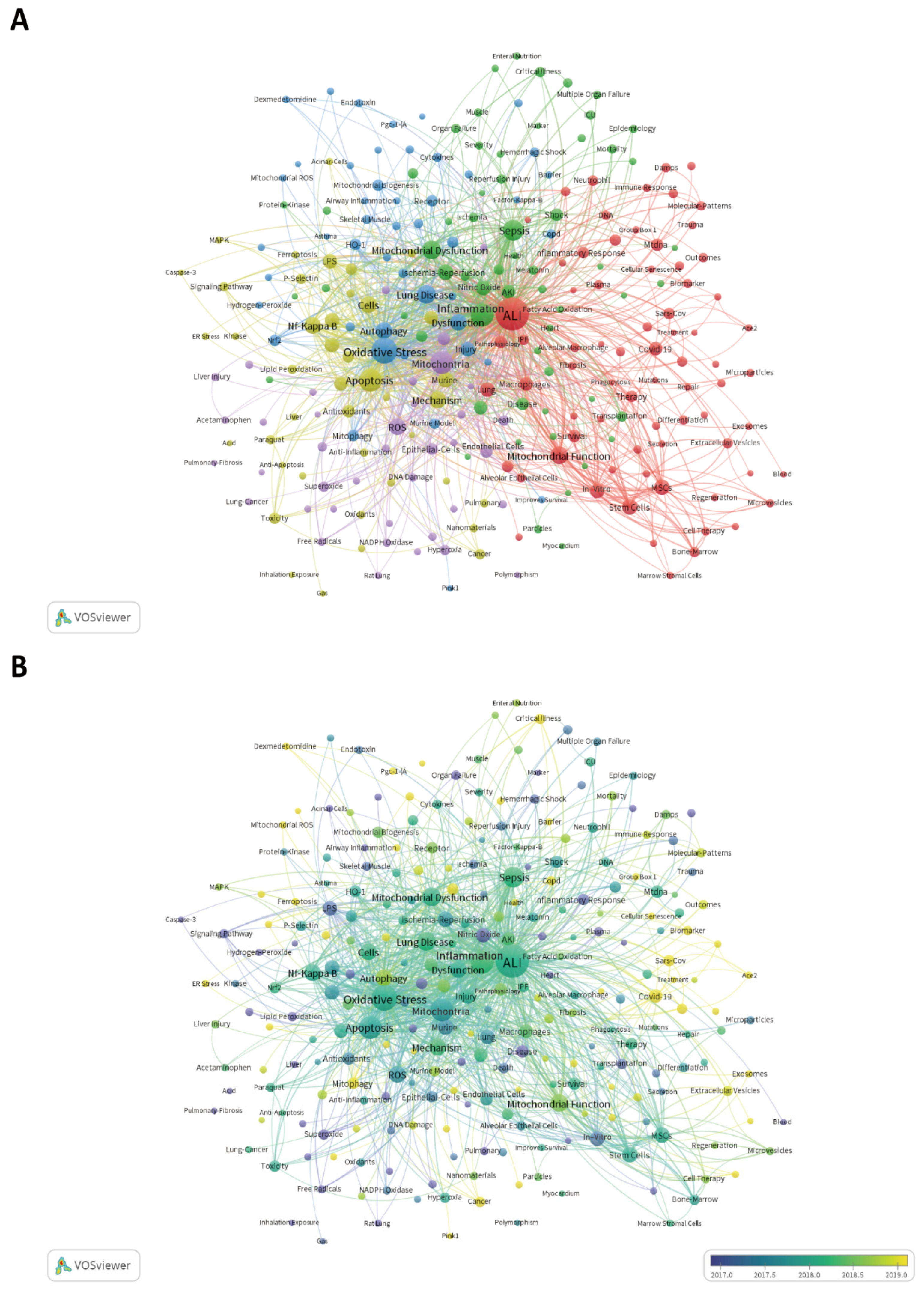

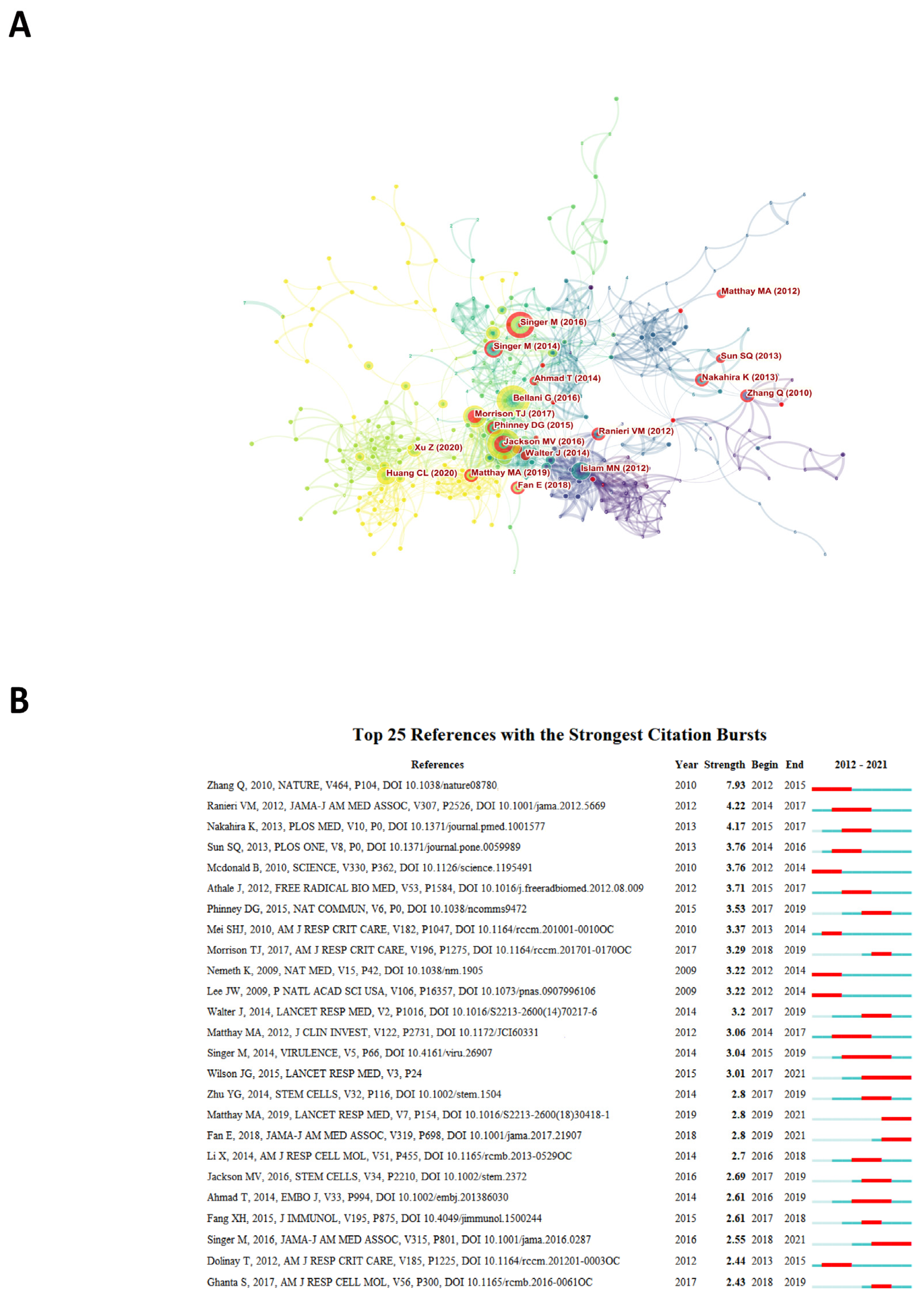
| Rank | Country/Region | Np | % of (756) | Nc | Na | H-Index |
|---|---|---|---|---|---|---|
| 1 | China | 327 | 42.58 | 6217 | 19.01 | 41 |
| 2 | USA | 270 | 35.16 | 9816 | 36.36 | 48 |
| 3 | Germany | 40 | 5.21 | 999 | 24.98 | 17 |
| 4 | Canada | 39 | 5.08 | 2019 | 51.77 | 24 |
| 5 | England | 35 | 4.56 | 1694 | 48.40 | 19 |
| 6 | Italy | 33 | 4.30 | 1148 | 34.79 | 21 |
| 7 | France | 29 | 3.78 | 977 | 33.62 | 16 |
| 8 | Japan | 21 | 2.73 | 486 | 23.14 | 13 |
| 9 | India | 20 | 2.60 | 338 | 16.90 | 8 |
| 10 | South Korea | 17 | 2.21 | 679 | 39.94 | 13 |
| Rank | Institutions | Country | Np | Nc | Na | H-Index |
|---|---|---|---|---|---|---|
| 1 | University of California System | USA | 29 | 1345 | 46.38 | 17 |
| 2 | US Department of Veterans Affairs | USA | 27 | 837 | 31.00 | 15 |
| 3 | Veterans Health Administration VHA | USA | 26 | 812 | 31.23 | 14 |
| 4 | Shanghai Jiao Tong University | China | 24 | 461 | 19.21 | 12 |
| 5 | Pennsylvania Commonwealth System of Higher Education PCSHE | USA | 20 | 713 | 35.65 | 11 |
| 6 | Harvard University | USA | 19 | 1273 | 67 | 18 |
| 7 | Sichuan University | China | 19 | 297 | 15.63 | 11 |
| 8 | University of Pittsburgh | USA | 19 | 706 | 37.16 | 11 |
| 9 | Chang Gung University | China | 18 | 660 | 36.67 | 11 |
| 10 | University of Toronto | Canada | 18 | 1204 | 66.89 | 15 |
| Rank | Journal | Np | Nc | Na | H-Index | IF (2021) |
|---|---|---|---|---|---|---|
| 1 | Am. J. Physiol.-Lung C | 28 | 736 | 26.29 | 17 | 6.011 |
| 2 | Free Radical. Bio. Med. | 20 | 759 | 37.95 | 15 | 8.101 |
| 3 | Int. J. Mol. Sci. | 20 | 451 | 22.55 | 10 | 6.208 |
| 4 | Oxid Med. Cell Longev. | 19 | 402 | 21.16 | 13 | 7.310 |
| 5 | PLoS ONE | 15 | 504 | 33.60 | 12 | 3.752 |
| 6 | Front Immunol. | 14 | 563 | 40.21 | 9 | 8.786 |
| 7 | Shock | 13 | 229 | 17.62 | 10 | 3.533 |
| 8 | Sci. Rep.-Uk | 11 | 157 | 14.27 | 7 | 4.996 |
| 9 | Am. J. Resp. Cell Mol. | 10 | 225 | 22.50 | 9 | 7.748 |
| 10 | Biomed. Pharmacother. | 9 | 110 | 12.22 | 6 | 7.419 |
Disclaimer/Publisher’s Note: The statements, opinions and data contained in all publications are solely those of the individual author(s) and contributor(s) and not of MDPI and/or the editor(s). MDPI and/or the editor(s) disclaim responsibility for any injury to people or property resulting from any ideas, methods, instructions or products referred to in the content. |
© 2022 by the authors. Licensee MDPI, Basel, Switzerland. This article is an open access article distributed under the terms and conditions of the Creative Commons Attribution (CC BY) license (https://creativecommons.org/licenses/by/4.0/).
Share and Cite
Hu, S.; Zhou, W.; Wang, S.; Xiao, Z.; Li, Q.; Zhou, H.; Liu, M.; Deng, H.; Wei, J.; Zhu, W.; et al. Global Research Trends and Hotspots on Mitochondria in Acute Lung Injury from 2012–2021: A Bibliometric Analysis. Int. J. Environ. Res. Public Health 2023, 20, 585. https://doi.org/10.3390/ijerph20010585
Hu S, Zhou W, Wang S, Xiao Z, Li Q, Zhou H, Liu M, Deng H, Wei J, Zhu W, et al. Global Research Trends and Hotspots on Mitochondria in Acute Lung Injury from 2012–2021: A Bibliometric Analysis. International Journal of Environmental Research and Public Health. 2023; 20(1):585. https://doi.org/10.3390/ijerph20010585
Chicago/Turabian StyleHu, Song, Wenyu Zhou, Sheng Wang, Zhuoran Xiao, Quanfu Li, Huanping Zhou, Meiyun Liu, Huimin Deng, Juan Wei, Wanli Zhu, and et al. 2023. "Global Research Trends and Hotspots on Mitochondria in Acute Lung Injury from 2012–2021: A Bibliometric Analysis" International Journal of Environmental Research and Public Health 20, no. 1: 585. https://doi.org/10.3390/ijerph20010585
APA StyleHu, S., Zhou, W., Wang, S., Xiao, Z., Li, Q., Zhou, H., Liu, M., Deng, H., Wei, J., Zhu, W., Yang, H., & Lv, X. (2023). Global Research Trends and Hotspots on Mitochondria in Acute Lung Injury from 2012–2021: A Bibliometric Analysis. International Journal of Environmental Research and Public Health, 20(1), 585. https://doi.org/10.3390/ijerph20010585






